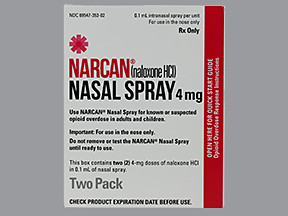NALOXONE SPRAY - NASAL
PHONETIC PRONUNCIATION: (nal-OX-one)
COMMON BRAND NAME(S): Narcan
GENERIC NAME(S): naloxone HCl
Uses
USES: This medication is used for the emergency treatment of known or suspected opioid (narcotic) overdose. Serious opioid overdose symptoms may include unusual sleepiness, unusual difficulty waking up, or breathing problems (ranging from slow/shallow breathing to no breathing). Other symptoms of overdose may include very small "pinpoint" pupils, slow heartbeat, or low blood pressure. If someone has serious overdose symptoms but you are not sure if he or she has overdosed, give this medication right away anyway, since lasting slow/shallow breathing may cause permanent damage to the brain, or death. This medication belongs to a class of drugs known as opioid antagonists. It works by blocking the effects of the opioid in the brain. This medication may not work as well to block the effects of certain types of opioids (mixed agonist/antagonists such as buprenorphine, pentazocine). With these types of opioids, blocking may be incomplete or you may need a higher dose of naloxone. The effects of naloxone will not last as long as the effects of the opioid. Since treatment with this medication is not long lasting, be sure to get medical help right away after giving the first dose of naloxone. Treatment of opioid overdose should also include breathing treatment (such as oxygen given through tubes in the nose, mechanical ventilation, artificial respiration).
How to use NALOXONE SPRAY - NASAL
HOW TO USE: See also Uses section. Read the Patient Information Leaflet and Instructions for Use provided by your pharmacist when you get this medication and each time you get a refill. Be sure to keep this medication handy in case it is needed. Learn ahead of time how to properly give this medication so you will be ready to use naloxone if needed. If you have any questions, ask your doctor or pharmacist. Remove the naloxone spray from the package only when you are ready to use it. Lay the person on their back. Tilt the person's head back and support their neck with your hand. Use your other hand to gently insert the tip of the spray nozzle into one nostril, then firmly press the plunger to give the dose. Remove the spray nozzle from the nostril and move the person onto their side as directed by the manufacturer. The effects of this medication are rapid but not long lasting. After giving naloxone, get medical help right away, even if the person wakes up. If symptoms return after giving the spray, give another dose in the other nostril every 2 to 3 minutes, changing sides of the nose with each dose. Each spray contains only one dose and cannot be reused. Continue to closely watch the person until emergency help comes. Tell the health care professional that you have given naloxone spray.
Side Effects
Precautions
Interactions
Overdose
Images
Reviews
Disclaimer
IMPORTANT: HOW TO USE THIS INFORMATION: This is a summary and does NOT have all possible information about this product. This information does not assure that this product is safe, effective, or appropriate for you. This information is not individual medical advice and does not substitute for the advice of your health care professional. Always ask your health care professional for complete information about this product and your specific health needs.

No Reviews Yet